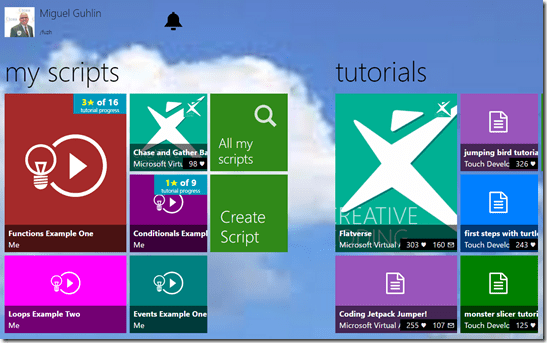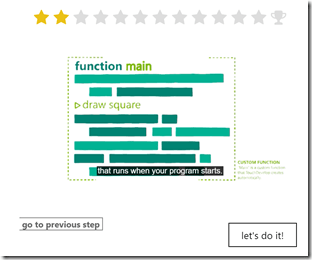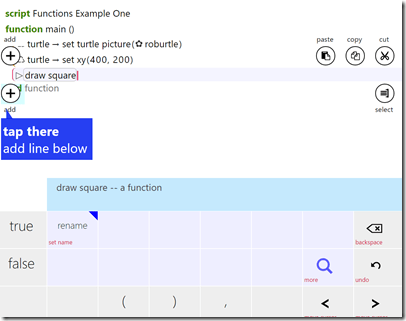For the eighth time, I tried to run the function that moved a turtle across my screen, hoping that it would finally draw a hexagon. It worked! Like a gold medalist, I stared in shock at the screen with a smile slowly spreading on my face.
Check out CCGA – Make Coding Fun for all!
For me, it was a personal moment of achievement. Since age thirteen, when I first tried to enter a program copied from Nibble magazine, I’d tried to craft and compile computer programs (a.k.a. coding), often without success. Yet here I was at the Creative Coding through Games and Apps (CCGA) being successful. Could there finally be hope for non-programmer types like me? With Touch Develop, the answer is a resounding YES. And you can bet your students will find this an engaging tool as they learn how to develop code that works.
Upcoming Opportunity: Register to attend the free TCEA Introduction to Creative Coding through Games and Apps on December 2, 2016 in Austin, Texas. This six-hour teacher academy provides an orientation to the Creative Coding through Games and Apps (CCGA) course curriculum and an introduction to the Touch Develop platform and online CCGA tutorials. The CCGA curriculum is intended for middle and high school classrooms, and no previous computer science or coding experience is needed. By attending, you’ll receive access to the curriculum which provides everything you need to deliver the content to your students in a variety of ways. You’ll also receive teacher prep materials, lesson plans, presentations, student assignments, homework, projects, and tests. If you have any questions about the training and/or CCGA curriculum, please contact Miguel Guhlin at mguhlin@tcea.org or 512-450-5392.
Why Learn to Code?
While many have argued that children need to learn to program, I previously found few reasons compelling. There are many ways to develop hands-on, minds-on opportunities to solve real-world problems. It wasn’t until earlier this year when the significance of IoT smacked me between the eyes. When you stop to think that there will be over 50 billion devices connected by 2020, a phenomenon known as the Internet of Things (a.k.a. IoT and/or the Internet of Everything (IoE)), and that each of those devices needs to be programmed for use, you may realize how critical learning to code is. Yet many students often don’t learn how to program until they are in high school, and only a few take it up or excel at it. That’s what makes Touch Develop, a way of creating programs on any device (e.g. Chromebook, Android, iOS, Mac, Linux, and Windows), such a powerful innovation to implement in schools today.
Listen to these two brief Voxercasts I recorded with the gentlemen who introduced me to CCGA:
- Voxercast with Gary Gillespie (NCCE), a co-facilitator for my CCGA learning session
- Voxercast with Paul Reynolds, the other co-facilitator for my CCGA learning session
What Makes Touch Develop Coding So Special?
“Dad,” asked my six-year old son a few years ago (he’s now 17), “I want to grow up to be a programmer and write games.” When I introduced him to MIT’s Scratch, he quickly lost interest. It was hard to imagine how Scratch, he told me later, would help him write a computer game like Medal of Honor or Command and Conquer, games that inspired him to want to learn to program. Touch Develop provides an approachable way to code that also manages student expectations and helps address the social and teaming aspects of game development. In this cross-platform, mobile coding environment, “Students learn by doing, creating simple games and apps.” Touch Develop, though, comes with a powerful, yet easy-to-follow curriculum chock-full of video tutorials and guided programming that can be completed on any device. This cross-platform goodness is accompanied, for the teacher, with an entire ecology of resources that educators and students can rely on. What’s more, Touch Develop provides an online, graphic-oriented, touch-screen-oriented development environment. You can develop on a computer, but any mobile device with enough screen real estate available will work, including Google Chromebooks. Simply put, whether you have iPads or Chromebooks as your device of choice, there’s little reason why students could not create and share their creations with others.
What Does Touch Develop Look Like?
 Notice in the two screenshots below, you first watch a tutorial and then “try out” the coding on your own. Fortunately, for those of us who may not be exactly great at writing code, Touch Develop provides an interactive tutorial. While you can work independently when writing a script, you also have an “expert at your elbow” to help you get it done.
Notice in the two screenshots below, you first watch a tutorial and then “try out” the coding on your own. Fortunately, for those of us who may not be exactly great at writing code, Touch Develop provides an interactive tutorial. While you can work independently when writing a script, you also have an “expert at your elbow” to help you get it done.
If above we see a tutorial, when you click “let’s do it!” you are taken to a screen where you can do just that.  Notice the “tap there” instructions that guide you, step by step, in developing the code by tapping on elements at the bottom of the screen to create ideas. Over time, I found myself beginning to understand what was happening in the script, which never happened before. Somehow, this approach has overcome my “math block,” easing me over the rough spots when I got stuck. That makes me confident that grades 6-12 students will be able to learn Touch Develop and use it to achieve quick success, creating a game or anything else.
Notice the “tap there” instructions that guide you, step by step, in developing the code by tapping on elements at the bottom of the screen to create ideas. Over time, I found myself beginning to understand what was happening in the script, which never happened before. Somehow, this approach has overcome my “math block,” easing me over the rough spots when I got stuck. That makes me confident that grades 6-12 students will be able to learn Touch Develop and use it to achieve quick success, creating a game or anything else.
For example, while “writing” a program, users are encouraged to use the touch screen on their mobile device (making code development on devices students have a real possibility). When complete, students are able to quickly publish and share their creations with others. Touch Develop relies on HTML5 for maximum compatibility across devices, making students’ creations usable and playable by all.
As you might imagine, this friendly programming environment is very different from the old approaches to programming that often reminded me of a blank page in a text editor. You are never alone without help and support in Touch Develop, which is invaluable to non-programmers who need scaffolded support to code.
How Can I Get My Students Started?
“Touch Develop,” shares Paul, the session facilitator and teacher at a recent Creative Coding through Games and Apps (CCGA) I attended, “tends to spread like wildfire. This course was built for grades 6-9 and has been used with 3rd-4th grade students as well. Others have used it as an after-school club.” It’s easy to see why that’s true because CCGA curriculum provides the support those teaching and learning Touch Develop need. As I worked my way through the tutorials and scripts, creating programs while grappling with coding concepts and FAILing forward (FAIL = First Attempt in Learning), I realized that schools had everything they needed to implement a complete course for students, as well as an environment rich enough to be used grades 3-16. The CCGA curriculum is available as a OneNote Notebook, making it easy to interact with, as well as Docx and PDF files divided up into units and lessons. Little is left to chance or to the teacher to develop.
Creative Coding through Games and Apps is a first-semester course for introduction to programming for the early secondary grades. The course is designed to attract and reach a broad and diverse range of students, including those who may have never before considered programming. Students learn how to code by working in a real software development environment to design, program, and publish mobile apps and games. Learning to code by creating real products, students discover how to make amazing things and have an impact on their world. Creative Coding through Games and Apps can be delivered with success by any teacher, regardless of computer science background. Featuring online and in-class lessons that emphasize hands-on coding, the course can be taught via any modern web browser on phones, tablets, laptops, or desktop computers. The combination of online plus in-class resources provides flexibility in teaching style, allowing educators to choose the right balance for their students of in-class instruction and out-of-class study. The course length is flexible, deliverable in 6, 9, 12, 18 weeks or more, depending on the time available in your school.
If you are interested in exploring CCGA andd/or Touch Develop further, be aware that you can get started online here. If you need help, let TCEA know via email to Miguel Guhlin (mguhlin@tcea.org) or Twitter @mguhlin.


